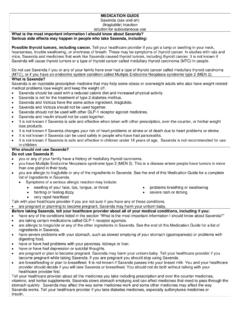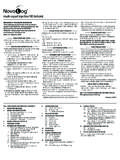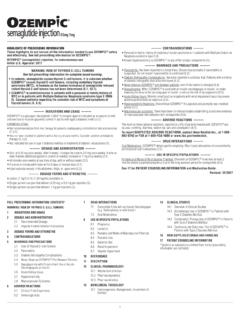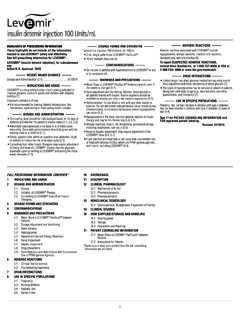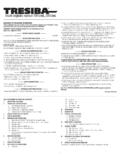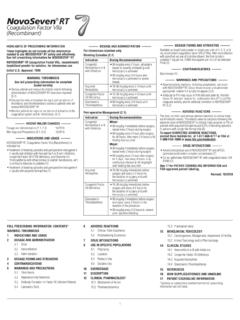Transcription of ADVERSE REACTIONS ——— ——— DOSAGE FORMS AND …
1 1 INDICATIONS AND USAGE Saxenda is a glucagon-like peptide-1 (GLP-1) receptor agonist indicated as an adjunct to a reduced-calorie diet and increased physical activity for chronic weight management in adult patients with an initial body mass index (BMI) of 30 kg/m2 or greater (obese) (1) or 27 kg/m2 or greater (overweight) in the presence of at least one weight-related comorbid condition ( hypertension, type 2 diabetes mellitus, or dyslipidemia) (1).Limitations of Use: Saxenda is not indicated for the treatment of type 2 diabetes (1).
2 Saxenda should not be used in combination with any other GLP-1 receptor agonist (1). Saxenda should not be used with insulin (1, ). The effects of Saxenda on cardiovascular morbidity and mortality have not been established (1). The safety and efficacy of coadministration with other products for weight loss have not been established (1). Saxenda has not been studied in patients with a history of pancreatitis (1, ). DOSAGE AND ADMINISTRATION Recommended dose of Saxenda is 3 mg daily.
3 Administer at any time of day, without regard to the timing of meals (2). Initiate at mg per day for one week. In weekly intervals, increase the dose until a dose of 3 mg is reached (2). Inject subcutaneously in the abdomen, thigh or upper arm (2). The injection site and timing can be changed without dose adjustment (2). DOSAGE FORMS AND STRENGTHS injection , pre-filled, multi-dose pen that delivers doses of mg, mg, mg, mg or 3 mg (6 mg/mL, 3 mL) (3). CONTRAINDICATIONS Personal or family history of medullary thyroid carcinoma or Multiple Endocrine Neoplasia syndrome type 2 (4, ).
4 Hypersensitivity to liraglutide or any product components (4, ). Pregnancy (4, ).17 PATIENT COUNSELING INFORMATION* Sections or subsections omitted from the full prescribing information are not PRESCRIBING INFORMATION: CONTENTS* BOXED WARNING: RISK OF THYROID C CELL TUMORS1 INDICATIONS AND USAGE2 DOSAGE AND ADMINISTRATION3 DOSAGE FORMS AND STRENGTHS4 CONTRAINDICATIONS5 WARNINGS AND PRECAUTIONS Risk of Thyroid C-cell Tumors Acute Pancreatitis Acute Gallbladder Disease Risk for Hypoglycemia with Concomitant Use of Anti-Diabetic Therapy Heart Rate Increase Renal Impairment Hypersensitivity REACTIONS Suicidal Behavior and Ideation6 ADVERSE REACTIONS Clinical Trials Experience Postmarketing Experience7 DRUG
5 INTERACTIONS Oral Medications8 USE IN SPECIFIC POPULATIONS Pregnancy Lactation Pediatric Use Geriatric Use Renal Impairment Hepatic Impairment Gastroparesis10 OVERDOSAGE11 DESCRIPTION12 CLINICAL PHARMACOLOGY Mechanism of Action Pharmacodynamics Pharmacokinetics13 NONCLINICAL TOXICOLOGY Carcinogenesis, Mutagenesis, Impairment of Fertility14 CLINICAL STUDIES16 HOW SUPPLIED/STORAGE AND HANDLING How Supplied Recommended StorageHIGHLIGHTS OF PRESCRIBING INFORMATIONT hese highlights do not include all the information needed to use SAXENDA safely and effectively.
6 See full prescribing information for SAXENDA .SAXENDA (liraglutide) injection , for subcutaneous use Initial Approval: 2010 WARNING: RISK OF THYROID C-CELL TUMORSSee full prescribing information for complete boxed warning. Liraglutide causes thyroid C-cell tumors at clinically relevant exposures in both genders of rats and mice. It is unknown whether Saxenda causes thyroid C-cell tumors, including medullary thyroid carcinoma (MTC), in humans, as the human relevance of liraglutide-induced rodent thyroid C-cell tumors has not been determined ( ).
7 Saxenda is contraindicated in patients with a personal or family history of MTC or in patients with Multiple Endocrine Neoplasia syndrome type 2 (MEN 2). Counsel patients regarding the potential risk of MTC and the symptoms of thyroid tumors (4, , ) . RECENT MAJOR CHANGES Boxed Warning ..9 /2016 Warnings and Precautions, Risk of Thyroid C-cell Tumors ( ) ..9 /2016 Warnings and Precautions, Acute Pancreatitis ( ) ..4 / 2017 Warnings and Precautions, Acute Gallbladder Disease ( ).
8 4 / 2017 Warnings and Precautions, Suicidal Behavior and Ideation ( ) ..4 / 2017 WARNINGS AND PRECAUTIONS Thyroid C-cell Tumors: See Boxed Warning ( ). Acute Pancreatitis: Discontinue promptly if pancreatitis is suspected. Do not restart if pancreatitis is confirmed ( ). Acute Gallbladder Disease: If cholelithiasis or cholecystitis are suspected, gallbladder studies are indicated ( ). Serious Hypoglycemia: Can occur when Saxenda is used with an insulin secretagogue ( a sulfonylurea).
9 Consider lowering the dose of anti-diabetic drugs to reduce the risk of hypogly-cemia (2, ). Heart Rate Increase: Monitor heart rate at regular intervals ( ). Renal Impairment: Has been reported postmarketing, usually in association with nausea, vomiting, diarrhea, or dehydration which may sometimes require hemodialysis. Use caution when initiating or escalating doses of Saxenda in patients with renal impairment ( ). Hypersensitivity REACTIONS : Postmarketing reports of serious hypersensitivity REACTIONS ( , anaphylactic REACTIONS and angioedema).
10 Discontinue Saxenda and other suspect medications and promptly seek medical advice ( ). Suicidal Behavior and Ideation: Monitor for depression or suicidal thoughts. Discontinue Saxenda if symptoms develop ( ). ADVERSE REACTIONS Most common ADVERSE REACTIONS , reported in greater than or equal to 5% are: nausea, hypoglycemia, diarrhea, constipation, vomiting, headache, decreased appetite, dyspepsia, fatigue, dizziness, abdominal pain, and increased lipase ( ).To report SUSPECTED ADVERSE REACTIONS , contact Novo Nordisk Inc.
